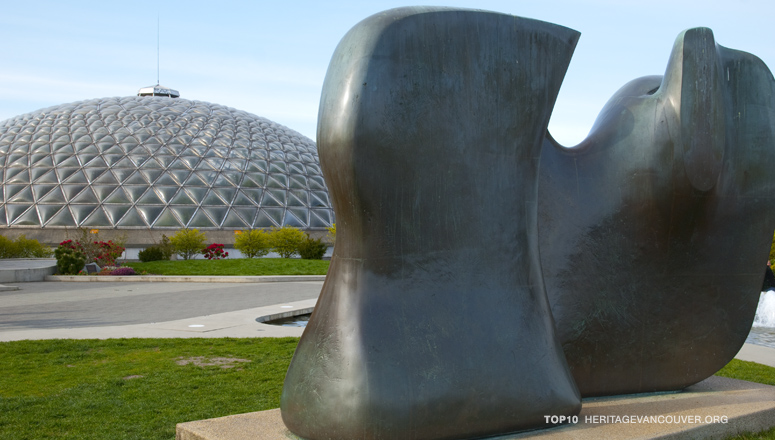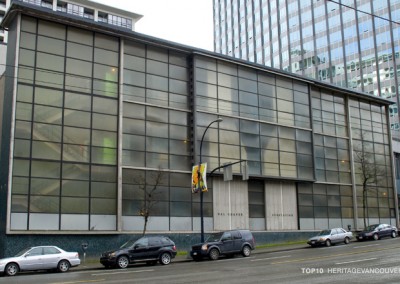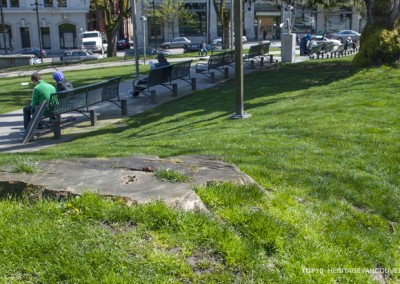The future of the Bloedel Conservatory is uncertain. The Vancouver Park Board announced it could no longer afford to operate the conservatory and may be unable to secure a new operator or it may secure an operator interested in introducing a use that is not compatible with the design and intent.
Significance
Why is the Bloedel Conservatory Significant?
The Bloedel Conservatory is significant because it is:
- an exciting modernist design that is listed as a class “A” heritage building on the City of Vancouver’s Heritage Register;
- part of a significant urban space, including a surrounding plaza with Henry Moore’s ‘Knife Edge’ sculpture that won the first Vincent Massey Award for Excellence in the urban environment in 1971; and
- listed on the Canadian Register of Historic Places.
The Bloedel Conservatory is significant for its historical, symbolic, cultural, and social values, and for its use of new technologies and building methods to create both a futuristic design and exotic ecological environment in Vancouver.
Befitting a forward-looking Canadian Centennial project for the City of Vancouver in 1967, the Bloedel Conservatory is symbolically significant for its avant-garde triodesic structure, an iconic construction popularized by Buckminster Fuller’s Expo 67 geodesic dome in Montreal.
The Conservatory is an important example of the Modernist interest in new building technologies. The geodesic structure and moulded plexiglass glazing enable the making of the large light-filled enclosure appropriate to its conservatory function. The open skeletal structure recalls the revolutionary metal and glass exposition structures of the 18th and 19th century and their function as horticultural showcases.
The Conservatory with its exotic birds and plants is also an important cultural extension of the early horticultural tradition in the city. City parks, including Queen Elizabeth Park, were the repositories for exotic plant and animal life for the wonder, entertainment and education of the citizenry.
While futuristic in imagery, its siting and civic tenure are also important as fulfillments of the Bartholomew Plan’s ideal of linking City Hall with the civic amenity of Queen Elizabeth Park.
The Conservatory reflects the spirit of philanthropy of a time when the resource extraction industries were undergoing a post-war expansion. These benefactors, in this case, lumberman Prentice Bloedel, wished to have their name associated with the cultural development of the City.
Threat
What is the threat to Bloedel Conservatory?
During the 2010 budget review, the Vancouver Park Board announced it could no longer afford to operate the Bloedel Conservatory. The Park Board issued a Request for Expressions of Interest for the operation and ideas for the future use of the facility in a similar or new capacity. The Park Board says it will continue to operate the Conservatory until April 30th, 2010 plus the additional month or two required to evaluate and finalize an agreement with the new operator.
The future of the Bloedel Conservatory is uncertain. The Park Board may be unable to secure a new conservatory operator or it may secure an operator interested in introducing a use that is not compatible with the design and intent of the Conservatory.
The original design objective closely linked the building with its contents. The intent was to create a natural effect, a closed environment of minimal consciousness of shelter and not compete with, but showcase the more than 300 varieties of tropical plants it contained.
History
Prentice Bloedel donated as a gift to the community 1.25 million dollars of the 1.4 million dollar cost of the Conservatory and the famous Henry Moore sculpture on the Conservatory plaza. He specified in the agreement dated 7 May, 1968 that it was to be operated by the City of Vancouver as a place of education for the people of Vancouver.
The Bloedel Conservatory opened on December 6th, 1969 with 10,000 people on hand to honour the first triodetic-domed floral conservatory in the world. In its first full year of operation, the Conservatory welcomed 500,000 visitors. Its futuristic appearance has been a significant draw. In 2003, it was used as a filming site for an episode of Battlestar Galactica and an episode of Gene Roddenberry’s Andromeda.
Over the years there has been a gradual decline in attendance from an average of 400,000 visitors in the seventies to 226,000 in 1986 and 73,000 in 2009. This significant drop in attendance can be attributed to several factors;
- the education program has been stopped;
- little attempt was made to refresh the visitor experience or effectively market the site;
- there is a no signage on Cambie and no public transportation to the site;
- from 2005 to 2008 the Canada Line on Cambie was under construction, making the site almost inaccessible; and
- from 2002 to 2008 the re-roofing of the reservoir, which includes the Knife Edge Sculpture Plaza and the Conservatory’s parking lot, took place; this long-running construction project disrupted site operations.
No educational and tourist attraction could survive this neglectful indifference, and the Conservatory has understandably suffered. Significantly, its attendance has skyrocketed once the site was threatened with closure.
Position
Heritage Vancouver’s Position
Heritage Vancouver supports the continued ownership of the Bloedel Conservatory by the City of Vancouver on behalf of the citizen’s of Vancouver.
The Park Board as stewards of the Bloedel Conservatory must ensure that it continues to operate as a Conservatory for the enjoyment and education of the people of Vancouver.
We urge the Park Board to identify a means of operating this important heritage facility that will include regular maintenance, cutting edge educational programs and an effective marketing system.
We urge the Vancouver Park Board to develop a Heritage Management Plan to assist it in carrying out an effective stewardship role with regard to all of the significant heritage resources under its direct control.



![3. Sir Guy Carleton School – Carleton Hall (1896) [saved]](http://heritagevancouver.org/wp-content/uploads/2011/11/HVS-Top10-795x440-carleton-400x284.jpg)



![7. Pantages Theatre (1907) [lost]](http://heritagevancouver.org/wp-content/uploads/2016/05/t10-pantages-B-795-400x284.jpg)


